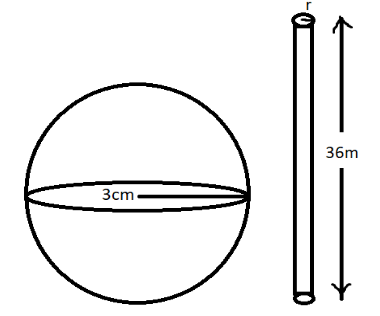
The diameter of a metallic sphere is 6 cm. The sphere is melted and drawn into a wire of uniform cross section. If the length of the wire is 36 m, find its radius.
Answer
504k+ views
Hint: For solving this problem, first we calculate the volume of the metallic sphere by using the diameter. Since the sphere is melted into a wire, the volume of both the materials must be the same. By using this fact, we can easily calculate the radius when the length of the wire is given to be 36 m.
Complete step-by-step solution -

According to the problem statement, we are given a metallic sphere of diameter 6 cm. So, the radius of the metallic sphere is 3 cm. For a sphere, volume can be expressed as: $V=\dfrac{4}{3}\pi {{r}^{3}}$
Putting r as 3 cm in above expression, we get
$\begin{align}
& V=\dfrac{4}{3}\pi \times {{\left( 3cm \right)}^{3}} \\
& V=\dfrac{4}{3}\pi \times 3\times 3\times 3c{{m}^{3}} \\
& V=4\pi \times 3\times 3{{m}^{3}} \\
& V=36\pi c{{m}^{3}}\ldots (1) \\
\end{align}$
The volume of the metallic sphere is $36\pi c{{m}^{3}}$.
Now, the sphere is melted so that it can be drawn into a wire of uniform cross-section. Therefore, the volume of both the materials should be the same. The length of the wire is given to be 36 m. Let the radius of the wire be r.
The volume of cylinder can be expressed as: $V=\pi {{r}^{2}}h$
Putting V as obtained in equation (1) and h = 3600 cm, we get the value of r as
$\begin{align}
& 36\pi c{{m}^{3}}=\pi {{r}^{2}}h \\
& 36\pi c{{m}^{3}}=\pi {{r}^{2}}\left( 3600cm \right) \\
& {{r}^{2}}=\dfrac{36\pi c{{m}^{3}}}{3600\pi cm} \\
& {{r}^{2}}=\dfrac{1}{100}c{{m}^{2}} \\
& r=\sqrt{\dfrac{1}{100}c{{m}^{2}}} \\
& r=\dfrac{1}{10}cm \\
\end{align}$
Therefore, the radius of cylindrical wire is 0.1 cm or 1 mm as 1cm is equal to 10mm.
Note: Students must be careful while evaluating the volume of two different shapes. The volume must be in similar units so that the final answer obtained is accurate. Hence, we converted all the values in cm to obtain uniformity.
Complete step-by-step solution -

According to the problem statement, we are given a metallic sphere of diameter 6 cm. So, the radius of the metallic sphere is 3 cm. For a sphere, volume can be expressed as: $V=\dfrac{4}{3}\pi {{r}^{3}}$
Putting r as 3 cm in above expression, we get
$\begin{align}
& V=\dfrac{4}{3}\pi \times {{\left( 3cm \right)}^{3}} \\
& V=\dfrac{4}{3}\pi \times 3\times 3\times 3c{{m}^{3}} \\
& V=4\pi \times 3\times 3{{m}^{3}} \\
& V=36\pi c{{m}^{3}}\ldots (1) \\
\end{align}$
The volume of the metallic sphere is $36\pi c{{m}^{3}}$.
Now, the sphere is melted so that it can be drawn into a wire of uniform cross-section. Therefore, the volume of both the materials should be the same. The length of the wire is given to be 36 m. Let the radius of the wire be r.
The volume of cylinder can be expressed as: $V=\pi {{r}^{2}}h$
Putting V as obtained in equation (1) and h = 3600 cm, we get the value of r as
$\begin{align}
& 36\pi c{{m}^{3}}=\pi {{r}^{2}}h \\
& 36\pi c{{m}^{3}}=\pi {{r}^{2}}\left( 3600cm \right) \\
& {{r}^{2}}=\dfrac{36\pi c{{m}^{3}}}{3600\pi cm} \\
& {{r}^{2}}=\dfrac{1}{100}c{{m}^{2}} \\
& r=\sqrt{\dfrac{1}{100}c{{m}^{2}}} \\
& r=\dfrac{1}{10}cm \\
\end{align}$
Therefore, the radius of cylindrical wire is 0.1 cm or 1 mm as 1cm is equal to 10mm.
Note: Students must be careful while evaluating the volume of two different shapes. The volume must be in similar units so that the final answer obtained is accurate. Hence, we converted all the values in cm to obtain uniformity.
Recently Updated Pages
What percentage of the area in India is covered by class 10 social science CBSE

The area of a 6m wide road outside a garden in all class 10 maths CBSE

What is the electric flux through a cube of side 1 class 10 physics CBSE

If one root of x2 x k 0 maybe the square of the other class 10 maths CBSE

The radius and height of a cylinder are in the ratio class 10 maths CBSE

An almirah is sold for 5400 Rs after allowing a discount class 10 maths CBSE

Trending doubts
The Equation xxx + 2 is Satisfied when x is Equal to Class 10 Maths

Why is there a time difference of about 5 hours between class 10 social science CBSE

Change the following sentences into negative and interrogative class 10 english CBSE

What constitutes the central nervous system How are class 10 biology CBSE

Write a letter to the principal requesting him to grant class 10 english CBSE

Explain the Treaty of Vienna of 1815 class 10 social science CBSE




